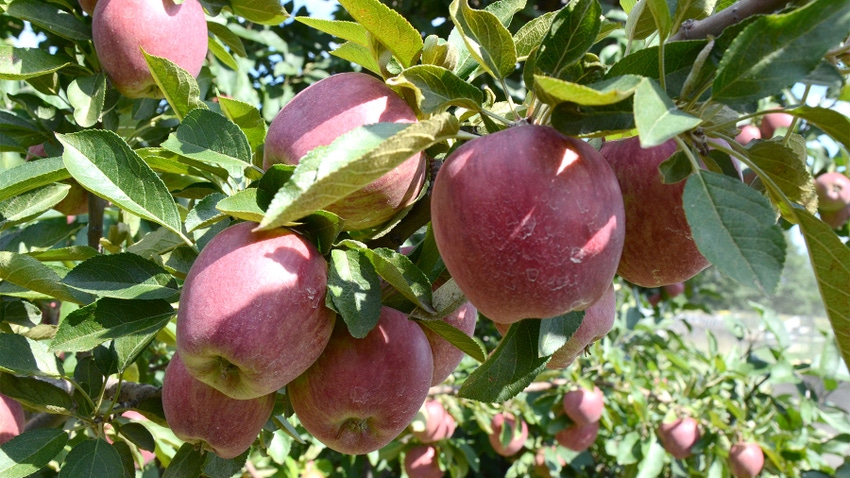
Can there be too much of a good thing? For anyone in agriculture, the answer is a definite yes — especially for specialty crops.
Sun, heat, rain … all good, unless you get too much! And, even when the balance is just right — the growing season is beautiful, and a bumper crop is produced — there is a point when too much yield produces consequences.
For the second year in a row, Michigan is swimming in apples, as is much of the eastern U.S. market. Michigan’s 32.38-million-bushel harvest in 2022 broke the state record, and while official reports are yet to be filed, many believe this year’s haul might push that high mark — or come very close.
A normal harvest has been typically between 24 million and 25 million bushels. Growers have concerns with massive back-to-back crops, as a glut may put downward price pressure on apples.
Even with USDA stepping in earlier this year with a $20 million purchase (benefiting various food nutrition assistance programs such as food banks) of the 2022 crop, there was still a carryover in controlled atmosphere storage of apples into the 2023, says Dawn Drake, Michigan Agricultural Cooperative Marketing Association’s (MACMA) manager.
“That’s the first time that has happened,” she says.
$100 million purchase
Thankfully, Drake says, USDA is stepping in with another purchase — $60 million for fresh apples and $40 million for processed apples from the nation’s 2023 harvest — to help reduce excess inventories and support farmers.
The Section 32 purchase is in addition to quarterly purchases of apple juice and applesauce that often go into the school lunch program, she says.
The purchase will benefit all apple-producing states, including New York — which USDA estimates a 26-million-bushel crop, down from its average of 29.5 million bushels annually. However, the late-May frost may have not dented the state’s yield as much as predicted.
Cynthia Haskins, president and CEO of New York Apple Association, says, “In recent conversations with N.Y. growers, it looks like production is around 28.5 million for this year."
Getting those apples picked has proved to be a bit of a challenge with “constant weekend rains that transpired around the Capital Region thwarting apple picking,” Haskins says. “New York retailers have been supportive of New York apples, and many stores are celebrating the fall season with front-of-produce-department displays”
The request for this purchase was made in October from MACMA with support from Michigan Sens. Debbie Stabenow and Gary Peters. The award was announced Nov. 9.
Any approved vendor across the country, vetted through USDA, can bid on the purchases and pay growers according to how they bid on the business.
The Agriculture Marketing Services solicits vendors on an ongoing basis for more than 200 different foods for programs. Products must be 100% domestically produced and processed.
Michigan again surpasses New York yields
Michigan has more than 34,500 apple-growing acres across 775 family farms, while New York’s 500 growers have orchards spanning more than 50,000 acres.
Typically, Michigan ranks third in the country in apple production behind No. 1 Washington and No. 2 New York. However, in the past two years, Michigan has replaced New York as the No. 2 apple-producing state in the country.
“Fifty percent or more of apple production east of the Mississippi is utilized for processing, so that processing component is very important for Michigan and Eastern states,” Drake says. “And Michigan is unique in that we have several fruit processors, so we typically benefit from USDA purchases.”
A Section 32 purchase is uncommon. “We don’t approach unless there are no other options,” Drake says. “The last time was 2016, before the 2022 crop purchase and 2023.
“When we saw the carryover, slow movement in fresh and processed apples, and then another huge crop coming on, there really was no choice other than to go back to USDA and ask for another Section 32 purchase,” she explains.
Food banks and home-feeding programs will benefit from 64-ounce apple juice jugs, 12 2.5-pound bags of individually quick-frozen apple slices, applesauce cups and soup-can sized containers of applesauce.
“Had USDA not agreed to this purchase, we would have growers sitting on a bunch of fruit with no home,” says Drake, who notes that several growers dumped the 2022 crop to make way for the 2023 harvest. “They needed the storage and bins, so it was either dumped or sold for minimal prices.”
While hard apple cider has been popular and a relatively new market, it uses less than 5% of total apple production. “Some are making a go of that market, but there have been manufacturers going out of business,” Drake says.
A challenge with the fresh market is Washington, the top state for apple production, also has a huge crop. “They typically export about 30% of their crop, but for several years they have not been able to do that because of tariffs,” Drake says. “The only place for Washington apples to go is East, and so that has really depressed the fresh market pricing.”
With a lot of young plantings now coming into production, Drake says it begs the question, “Is this the new normal? Some growers say maybe, while others say they can’t imagine having a third year of record yields,” she says. “We urge consumers … go buy apples.”
Read more about:
ApplesAbout the Author(s)
You May Also Like






